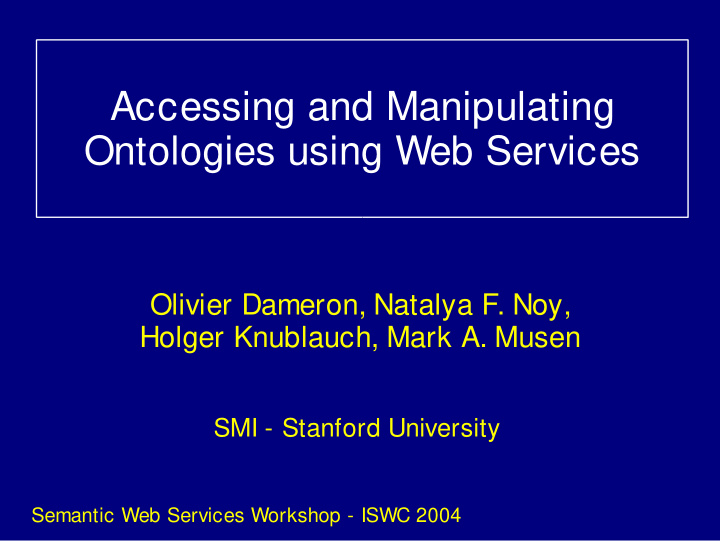



Accessing and Manipulating Ontologies using Web Services Olivier Dameron, Natalya F. Noy, Holger Knublauch, Mark A. Musen SMI - Stanford University Semantic Web Services Workshop - ISWC 2004
Context Semantic Web Ontology scope Web Services scope Ontology and WS address complementary needs acceptance in industry
Current limitations: WS need semantic descriptions WS operate on data that conform to an (implicit) understanding shared between the provider and the client WSDL, UDDI Still require human intervention for composition for interfacing Need explicit description of What WS do What they operate on
Current limitations: WS need semantic descriptions WS operate on data that conform to an (implicit) understanding shared between the provider and the client WSDL, UDDI Still require human intervention for composition for interfacing Explicit description of What WS do OWL-S What they operate on ONTOLOGIES
Current limitations: WS need ontology-manipulation tools access to semantic descriptions process of semantic descriptions WS also need to access to these tools OWS Ontology Web Services Ontology manipulation tools Implemented as Web Services
Ontology Web Services ∃ some generic ontology manipulation tools standard bricks for leveraging SW develoment (so that previous investments start to pay off) cumulative effect allow to build on technologies accepted by the business world (amazon, google...) for human AND for programs (automation) These tools can be implemented as Web Services
Approach 1. Identify major classes of Ontology manipulation tools 2. Architecture Web Services assessing relevance of regular WS achieving interoperability OWL-S description of OWS
OWS Capabilities Queries Views Translations Mapping Versioning Merging Reasoning
OWS Capabilities Ontology Ontology VIEW OWS View def. Ontology Ontology TRANSLATION Language Ontology Variables QUERY OWS mapping Query string
Architecture Semantic description of (regular) Web Services (semi) automatic discovery automatic invocation composition and interoperability Interconnection OWL-S / OWS hinges on OWL-S enable use of OWL-S
OWS for assessing WS relevance OWL-S 1 Description WS Client
OWS for assessing WS relevance OWS OWS OWS Reasoning Mapping ... 2 OWL-S 1 Description WS Client
OWS for assessing WS relevance OWS OWS OWS Reasoning Mapping ... 2 OWL-S 1 Description WS Client WS 3 Server
OWL-S description of OWS may be necessary OWS OWS OWS Reasoning Mapping ... 2 OWL-S 1 Description WS Client WS 3 Server
OWS for semantic interoperability Compute WS Input params WS Relevance OWS OWS (prev. slide) 3 2 OWL-S 1 Description WS Client
OWS for semantic interoperability Compute WS Input params WS Relevance OWS OWS (prev. slide) 3 2 OWL-S 1 Description WS Client WS 4 Server
OWS for semantic interoperability Compute WS Compute WS Output params Input params WS Relevance OWS OWS OWS (prev. slide) 5 3 2 OWL-S 1 Description WS Client WS 4 Server
Discussion Relies on existing widespread technologies from design to implementation era Not suited for every business domain ontology of the domain (amazon vs. medical app) semantically rich and structured domains Chicken and egg problem OWS broker ?
Conclusion Identify some generic ontology-manipulation functions Use of OWS for linking isolated resources OWS = semantic duct tape OWS also play a role in the SW development Automatic (as much as possible) processing of OWL-S descriptions
Recommend
More recommend